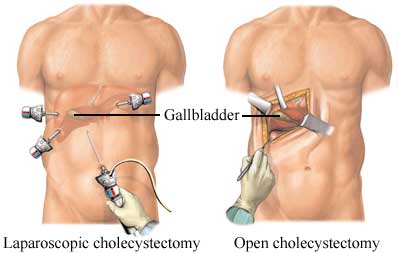A cholecystectomy is surgery to remove the gallbladder. It is the most common way to treat gallstones that are causing problems. Any stones that are in the bile ducts will also be removed. The ducts will be left in place so the liver can keep releasing bile into the intestine to help with digestion.
This surgery may be done in one of two ways:
| Laparoscopic Cholecystectomy vs. Open Cholecystectomy |

|
| Copyright © 2002 Nucleus Communications, Inc. All rights reserved. |
Laparoscopic Cholecystectomy
Laparoscopic cholecystectomy results in less bleeding and can shorten recovery time. During surgery, small cuts will be made in the belly. A small scope will be passed through one of the openings. It will send images of the gallbladder to a screen to help guide tools. Other tools will be inserted. The gallbladder will be separated from the liver, ducts, and other structures. The cystic duct is cut and the gallbladder is removed. Any stones will also be removed.
Open Cholecystectomy
An open surgery may be done in some people, such as if they have scarring from past surgeries. The recovery time will be longer. During this surgery, a large cut is made in the belly. The gallbladder will be separated from the liver, ducts, and other structures. The cystic duct is cut and the gallbladder is removed. Any stones will also be removed.
References
Gallstones. Cleveland Clinic website. Available at: https://my.clevelandclinic.org/health/diseases/7313-gallstones. Accessed March 17, 2022.
Gallstones. EBSCO DynaMed website. Available at: https://www.dynamed.com/condition/gallstones. Accessed March 17, 2022.
Gallstones. National Institute of Diabetes and Digestive and Kidney Diseases website. Available at: https://www.niddk.nih.gov/health-information/digestive-diseases/gallstones. Accessed March 17, 2022.
Revision Information
- Reviewer: EBSCO Medical Review Board Daniel A. Ostrovsky, MD
- Review Date: 11/2021
- Update Date: 03/17/2022
